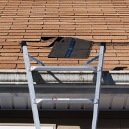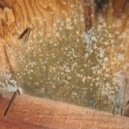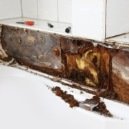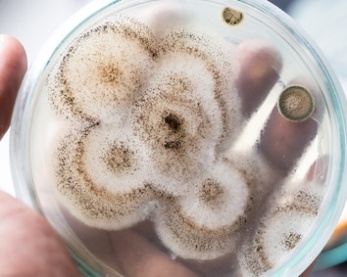Find a pre-screened local mold removal specialist Free Estimate
Find a Mold Specialist Now
Click or Call, Toll-Free 24/7
Arthrinium Mold
Arthrinium mold is a category of mold that grows in soil and plants. Though this mold type is common outdoors, you can also find it indoors if the conditions are right. Known to be potentially allergenic, arthrinium is capable of producing mycotoxins and may cause health problems such as fever, asthma, and allergies.
This mold type grows rapidly, and its colonies are cottony to woolly, white in color with brown spots on the exterior. If you spot this mold or any other type of mold in your home, it is best to take immediate action before it spreads and becomes an expensive and hazardous problem.
Arthrinium Mold in Your Home
Whether it's the fuzzy white clusters on your attic floor or slimy black spots in your bathroom, the presence of mold in your house can be detrimental to both your health and your wallet. Whether or not you are allergic to mold, extended exposure to it can result in a multitude of health troubles, including eye irritation, skin allergies, sore throat, and lung issues. People who are especially sensitive to the effects of mold include children and infants, pregnant women, senior citizens, people with weak immune systems, and people with chronic lung disease.
So, what exactly is mold? Mold is a type of fungus that is made of small organisms that you can find both indoors and outdoors. Thriving on moisture and reproducing through lightweight airborne spores, mold is virtually unavoidable. When you encounter mold in small amounts, it is generally harmless. However, when mold establishes a colony in your home and starts multiplying, it can turn into a major problem.
Places Susceptible to Arthrinium Mold Growth
Mold growth usually takes place on your walls, carpet, furniture, wood trim or sheathing. Mold needs dampness to grow, so you are likely to find it in moist places like kitchens, bathrooms, basements, crawl spaces, laundry rooms or anywhere there is a leak. If you experience any of the following symptoms that won't go away, it could be an indicator of mold exposure:
- Runny nose/congestion that won’t go away
- Sneezing or coughing
- Red, irritated eyes
- Sore throat
- Weakness and tiredness
- Light sensitivity, and headaches
- Poor memory
- Trouble concentrating
- Unusual skin problems, numbness and a tingling sensation under the skin
- Appetite swings, and body temperature regulation issues
- Sweats, blurred vision, sharp pains, mood swings
- Bloating, abdominal pain, diarrhea
- Vertigo
- Static shocks
The best course of action when dealing with mold exposure symptoms is to remove yourself from the environment right away. Avoid bringing any items with you that could be moldy, and see your doctor as soon as possible. Ask your doctor if it is safe for you to return to your home, or if you should wait until the mold has been removed.
If there is any water seepage or water leaks present in your property, fix them as soon as possible. If water is entering your house from an external source due to poor drainage, you should have a landscaper re-grade the property. If you have basement leaks or foundation cracks you should also have a waterproofing contractor come in to inspect your walls and to repair any damage.
Some other things you can do to prevent water from getting into you home include improving groundwater drainage by relocating plants and shrubbery from around the foundation. Plants and bushes should always be kept at least three feet away from the foundation. You should clean debris and leaves out of your home’s gutters on a regular basis. In your home, don’t let clutter build up, especially in rooms below ground level that are prone to moisture. Dispose of old newspapers, books and storage boxes.
While these tips will help, your health issues will not improve until the arthrinium mold is removed from your home.
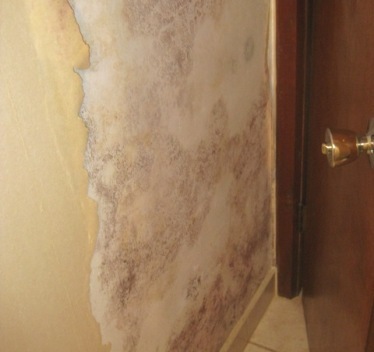 Mold under wallpaper in bathroom
Mold under wallpaper in bathroomRemoving Mold Efficiently
Mold removal is a quick and easy process that you can handle easily via the “do-it-yourself” route, right? Wrong. This is a common misconception among many home and business owners when it comes to mold removal, which is why it is best to leave this project to a mold removal specialist. Listed below are some reasons why it can be smart to contact a mold removal expert:
- Avoid Health Risks: Exposure to mold, especially without the right tools and protective gear, can be harmful and cause a number of problems due to exposure to mold spores and mycotoxins. Expert mold removal contractors have all the necessary tools, equipment, and knowledge to protect them when remediating the mold.
- A Thorough Cleaning: Sure, you can watch YouTube tutorials about mold removal or read helpful articles, but unless you have the expertise and the right equipment, there is no guarantee that the mold will not come back. In addition, most mold spores are not visible, and can thus be missed easily. For example, even though you can see the mold on your walls, mold can also be inside your walls, under carpets, or growing under your subfloors. A professional mold removal company knows how to find all the mold in your home, and knows the correct removal protocols to make sure it is all safely removed.
- Mitigate the Spread of Mold: The cleanup process will release some mold spores into the air and spread them across the house. If you are performing do-it-yourself procedures, you could actually end up spreading the mold even more. Professionals set up containment to prevent the mold from spreading. They start by establishing negative air pressure in all of the affected areas. They collect any mold spores in a HEPA air cleaner, or exhaust them into the outside air. If any spores are missed, they can start to grow and spread again, especially if they enter your HVAC system or come into contact with any moisture. Mold cleaning experts know how to prevent the spread of mold spores. Moreover, they will let you know if you require any additional services, like duct cleaning, or AC inspection services.
- Unearth the Source: Removing mold will not help in the long run if you are unaware of the root cause. Expert mold services will do more than just eliminate the existing mold source; they determine the source of your mold problem, and eliminate it so that the mold does not return.
If you are facing a mold issue, you can follow this link to get a list of mold removal experts in your area that provide free, no-obligation home inspections and estimates for removal. You have nothing to lose, and if you are considering removing the mold yourself, an experts opinion will only help you.
Free Home Inspection By A Mold Removal Specialist
Search This Website
Recent Articles
-
See Our 5 Recommended Mold Removal Companies in Covington, KY
Apr 16, 25 12:59 PM
-
See Our 5 Recommended Mold Removal Companies in Wheaton, IL
Jun 20, 24 10:33 AM
-
See Our 5 Recommended Mold Removal Companies in Aberdeen, SD
Oct 08, 21 04:05 PM
